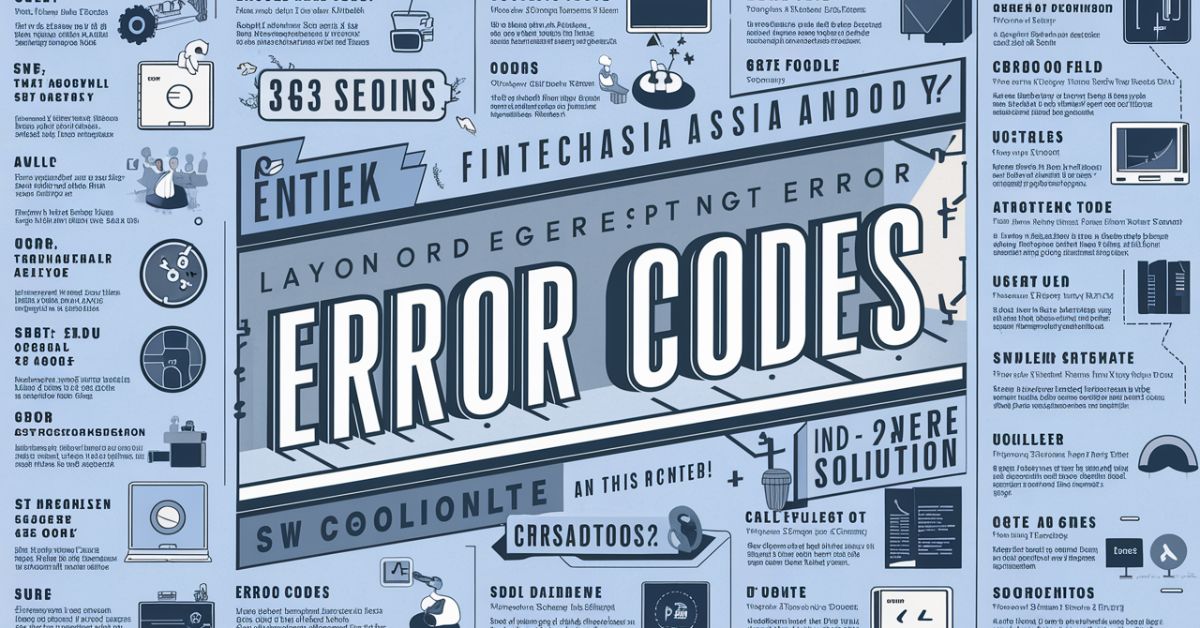In the rapidly evolving world of financial technology error codes serve as crucial indicators of system health and performance.
FintechAsia a leading platform in the Asian fintech landscape employs a comprehensive error code system to help developers system administrators and users identify and resolve issues quickly and efficiently.
This article delves into the intricacies of FintechAsia error codes exploring common causes diagnostic approaches and effective solutions.
Read This Blog:Unveiling The Oppo K3 8/512: Power, Style, And Innovation
What Is The FintechAsia Error Code System?

The FintechAsia Error Code System is a standardized method of categorizing and identifying various issues that may occur within the platform’s ecosystem.
These codes are designed to provide specific information about the nature of the problem its potential causes and in many cases suggested steps for resolution.
The error code system typically follows a structured format:
- Prefix:Indicates the general category of the error (e.g., AUTH for authentication, API for API-related issues)
- Numeric Code:A unique identifier for the specific error
- Description:A brief explanation of the error
For example an error code might look like this: AUTH-001: Invalid authentication token
This standardized approach allows for quick identification and streamlined troubleshooting processes across the platform.
Read This Blog:All Access Technologies 402-699-2575: Your Gateway to Cutting-Edge Security Solutions
Common Causes Of FintechAsia Error Codes

Understanding the root causes of error codes is essential for effective problem-solving.
Let’s explore some of the most common reasons behind FintechAsia error codes:
1. Network Connectivity Issues
Network problems are often at the heart of many error codes.These can include:
- Intermittent internet connections
- Firewall blockages
- DNS resolution failures
- VPN connectivity problems
When network issues arise they can trigger a range of error codes related to timeouts connection failures or data transmission errors.
2. Database Errors
Database-related issues can lead to various error codes particularly those involving data retrieval storage or manipulation.Common database errors include:
- Connection timeouts
- Query execution failures
- Data integrity issues
- Deadlocks or race conditions
These errors can significantly impact the performance and reliability of financial transactions and data processing within the FintechAsia platform.
3. API Integration Failures
As FintechAsia relies heavily on API integrations for various functionalities failures in these integrations can result in numerous error codes.Possible causes include:
- Incorrect API endpoints
- Authentication failures
- Rate limiting issues
- Incompatible data formats
API-related error codes often require a deep understanding of the specific integration points and the expected data exchange formats.
4. Security Breaches
Security-related issues can trigger a range of error codes designed to protect the integrity of the system and user data.These may include:
- Unauthorized access attempts
- Suspicious transaction patterns
- DDoS attacks
- Encryption failures
Security-related error codes are crucial for maintaining the trust and safety of the FintechAsia platform.
5. System Maintenance And Updates
Planned or unplanned system maintenance and updates can sometimes lead to temporary error codes.These may occur due to:
- Server restarts
- Database migrations
- Software updates
- Infrastructure changes
While these errors are often temporary they can still impact user experience and require clear communication to affected parties.
Authentication And Authorization Errors
Authentication and authorization errors are among the most common issues encountered in the FintechAsia platform.These errors typically occur when users attempt to access resources or perform actions without proper credentials or permissions.
Common authentication and authorization error codes include:
- AUTH-001:Invalid authentication token
- AUTH-002:Expired session
- AUTH-003:Insufficient permissions
- AUTH-004:Account locked
To resolve these errors users may need to:
- Re-authenticate their session
- Update their permissions
- Contact support for account-related issues
API Request Errors
API request errors often stem from issues with the way client applications interact with the FintechAsia API.These can range from simple formatting mistakes to more complex integration problems.
Examples of API request error codes:
- API-001:Invalid request format
- API-002:Missing required parameters
- API-003:Rate limit exceeded
- API-004:Unsupported API version
Developers should carefully review API documentation and implement proper error handling to manage these issues effectively.
Data Validation Errors
Data validation errors occur when the information provided to the FintechAsia platform does not meet the required format, type or range specifications.
Common data validation error codes include:
- VAL-001:Invalid date format
- VAL-002:Amount exceeds allowed limit
- VAL-003:Invalid currency code
- VAL-004:Duplicate transaction ID
Resolving these errors typically involves carefully reviewing input data and ensuring it adheres to the specified requirements.
Transaction Processing Errors

Transaction processing errors are particularly critical in a fintech platform as they directly impact financial operations.These errors can occur at various stages of a transaction lifecycle.
Examples of transaction processing error codes:
- TRX-001:Insufficient funds
- TRX-002:Transaction timeout
- TRX-003:Beneficiary account not found
- TRX-004:Currency conversion failed
Resolving these errors often requires coordination between multiple parties and may involve manual intervention in some cases.
Integration Errors

Integration errors arise when there are issues with the connections between FintechAsia and external systems or services.These can be particularly challenging to diagnose and resolve due to their interdependent nature.
Common integration error codes:
- INT-001:External service unavailable
- INT-002:Data synchronization failed
- INT-003:Webhook delivery failure
- INT-004:Third-party API rate limit exceeded
Resolving integration errors often requires collaboration between FintechAsia support teams and external service providers.
Account-related Errors
Account-related errors typically involve issues with user accounts profiles or settings within the FintechAsia platform.
Examples of account-related error codes:
- ACC-001:Account not verified
- ACC-002:KYC documentation incomplete
- ACC-003:Account suspended
- ACC-004:Password reset required
Users encountering these errors may need to update their account information or contact customer support for assistance.
Compliance And Regulatory Errors
Compliance and regulatory errors are particularly important in the fintech industry where adherence to financial regulations is crucial.
Common compliance and regulatory error codes:
- REG-001:Transaction exceeds regulatory limit
- REG-002:Prohibited jurisdiction
- REG-003:Suspicious activity detected
- REG-004:Required regulatory report not filed
Resolving these errors often involves careful review of regulatory requirements and may require legal or compliance team involvement.
System And Infrastructure Errors
System and infrastructure errors relate to issues with the underlying technology stack that powers the FintechAsia platform.
Examples of system and infrastructure error codes:
- SYS-001:Database connection failure
- SYS-002:Server overload
- SYS-003:Cache invalidation error
- SYS-004:Load balancer failure
These errors typically require attention from DevOps or infrastructure teams to resolve.
Security-related Errors
Security-related errors are designed to protect the integrity and confidentiality of the FintechAsia platform and its users’ data.
Common security-related error codes:
- SEC-001:IP address blocked
- SEC-002:Two-factor authentication failed
- SEC-003:Encryption key rotation required
- SEC-004:Potential SQL injection attempt detected
Addressing these errors often involves a combination of user action and platform security measures.
How to Diagnose FintechAsia Error Codes
Effective diagnosis of FintechAsia error codes is crucial for timely resolution.Here’s a step-by-step approach to diagnosing these errors:
1. Understanding Error Codes
- Familiarize yourself with the error code structure
- Review the error description for initial insights
- Check if the error is user-specific or system-wide
2. Common Error Code Categories
- Identify which category the error falls under (e.g., authentication, API, transaction)
- Understand the typical issues associated with that category
3. Using the Error Code Database
- Access the FintechAsia Error Code Database
- Search for the specific error code
- Review documented causes and suggested solutions
4. Troubleshooting Steps
- Follow the recommended troubleshooting steps for the error
- Check system status pages for any known issues
- Review recent changes or updates that might have triggered the error
5. Seeking Additional Help
- Consult the FintechAsia developer community forums
- Contact FintechAsia support for persistent or complex issues
- Provide detailed information about the error and steps to reproduce it
Common Issues With Quick Solutions
Here are some frequently encountered issues and their quick solutions:
- Invalid authentication token (AUTH-001):
- Re-authenticate the user session
- Check if the token has expired and request a new one
- API rate limit exceeded (API-003):
- Implement proper rate limiting in your application
- Consider upgrading your API plan for higher limits
- Insufficient funds (TRX-001):
- Verify the account balance
- Explore alternative funding options or reduce the transaction amount
- External service unavailable (INT-001):
- Check the status of the external service
- Implement proper error handling and retry mechanisms
- Account not verified (ACC-001):
- Guide the user through the account verification process
- Ensure all required documentation is submitted
Best Practices for Error Handling and Resolution
To minimize the impact of errors and improve overall system reliability consider the following best practices:
- Implement comprehensive error logging and monitoring
- Develop clear error messages for end-users
- Create and maintain up-to-date error code documentation
- Establish escalation procedures for critical errors
- Regularly review and update error handling processes
- Conduct post-mortem analyses for significant incidents
- Provide ongoing training for support and development teams
- Implement proper API versioning to manage changes
- Use feature flags for gradual rollouts of new functionality
- Maintain open communication channels with users during outages or major issues
Frequently Asked Questions
What Are FintechAsia Error Codes?
FintechAsia Error Codes are standardized identifiers for issues within the platform providing information about the nature of the problem and potential solutions.
How Can I Check If A Server Overload Is Causing Errors?
Monitor system performance metrics check error logs for SYS-002 codes and review the FintechAsia status page for any reported issues.
What Should I Do If I Encounter A Network Connectivity Error?
Check your internet connection verify firewall settings and ensure VPN configurations (if applicable) are correct.If issues persist contact your network administrator.
How Often Should Software Updates Be Performed To Prevent Errors?
Regular updates are crucial.Follow FintechAsia’s recommended update schedule typically monthly for minor updates and quarterly for major releases.
Where Can I Find More Information About Specific FintechAsia Error Codes?
Consult the FintechAsia Error Code Database developer documentation or contact FintechAsia support for detailed information on specific error codes.
Final Thoughts
Understanding FintechAsia error codes is key to maintaining a smooth-running fintech platform.By knowing common issues and their solutions you can quickly resolve problems and improve user experience.Remember error codes aren’t just problems – they’re opportunities to make your system better and more reliable.

William is a passionate fashion enthusiast with a keen eye for style trends.
With a background in textile design and years of experience in the Tech industry, William brings a unique perspective to his writing. He loves exploring sustainable fashion and street style.








